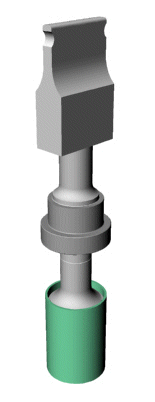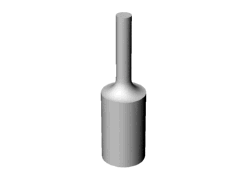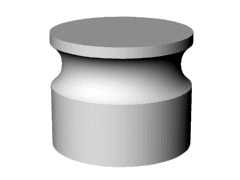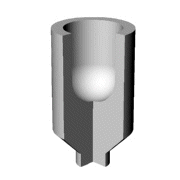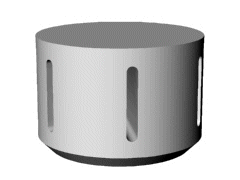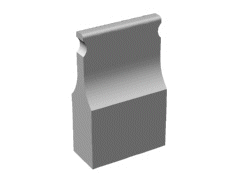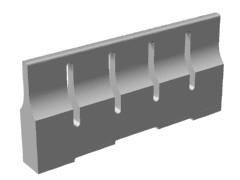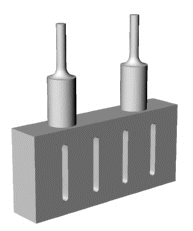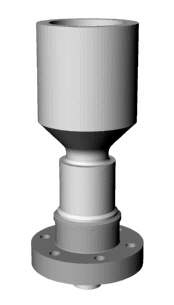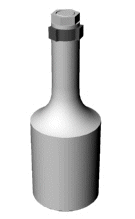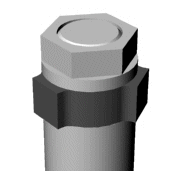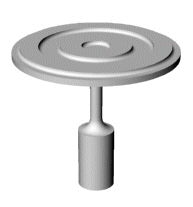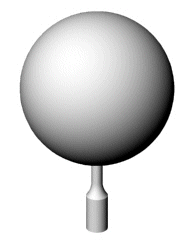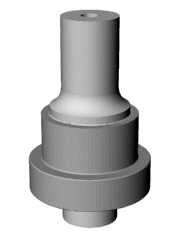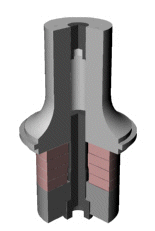|
Industrial resonators deliver high energy density in order to substantially affect the materials with which they are in contact. Common uses include welding of plastics and nonferrous metals, cleaning, abrasive machining of hard materials, cutting, enhancement of chemical reactions (sonochemistry), liquid processing, defoaming, and atomization. Usual frequencies are between 15 kHz and 40 kHz, although frequencies can range as low as 10 kHz and as high as 100 kHz. Krell Engineering can design many variations of the resonators shown below. (Note: not all resonators are shown to the same scale.) A typical industrial ultrasonic stack consists of a horn, booster, and transducer (converter).
|
Type |
Typical shape | Description |
| Simple |
|
Solid horns with a simple geometry (stepped, exponential, or catenoidal).
May have a replaceable tip. Can have high gain. Used for plastic spot welding and inserting and liquid processing. |
| Spool |
|
Solid horn with a spool shape and large diameter (up to 1/2 wavelength).
Has good amplitude uniformity across the face (generally >= 90%) and relatively low
stress. Face must be flat or have only minor relief. Low gain. Used for plastic welding of circular parts and liquid processing. |
| Bell |
3/4 section |
Unslotted horn with a cavity that extends to the node. Maximum diameter is
generally <= 0.4 * wavelength. Moderate gain. May have considerable radial face
amplitude. Used for plastic welding of circular parts and liquid processing. |
| Slotted |
|
Large diameter horn with radial or cross-slots. Diameter usually >= 0.4
* wavelength. May have a face cavity. Low gain. Used for plastic welding of circular parts. |
Bar horns
A bar horn has a rectangular output face and is either unslotted or has slots in one direction only. The horn thickness is generally <= 0.35 * wavelength.
Type |
Typical shape | Description |
| Unslotted |
|
Horn width is generally <= 0.4 * wavelength. Moderate gain. Used for plunge and scan welding and for some liquid processing applications (e.g., ultrasonic soldering). |
| Slotted |
|
Horn width is generally >= 0.4 * wavelength. Special design techniques
give optimum face amplitude uniformity. Moderate gain. Used for plunge and scan welding. |
Block horns
A block horn has a rectangular output face and has slots in two perpendicular directions.
Type |
Typical shape | Description |
| Block |
|
Width and thickness are generally >= 0.4 * wavelength. Low gain. Used for plastic welding of large, flat, rectangular parts. |
Special horns
| Composite |
|
High gain tip horns are driven by a common mother horn. Used for spot welding of plastics and for liquid processing. |
| Contoured | ____________ |
A horn that has a complex, often irregular shape machined into its face. Used for plastic welding. |
|
|
This bell horn has an integral booster and is designed for liquid processing. The rigid mount flange provides a hermetic seal against the wall of the pressure vessel. |
| Metal welding |
Tip and nut details |
Metal welding horns have a replaceable annular tip (typically tool steel) that is secured by a nut. The tip has multiple welding lobes. |
|
|
The resonator is driven axially but the disk vibrates radially. Designed
for use with a rigid mount booster. Used for rotary seam welding of plastics. |
| Flexure disk |
|
The flexure disk is driven axially at its center but vibrates in bending
with circular nodes. The amplitude decreases from the center to the edge. Compared to
conventional horns, the disk has a large surface area with low mass. With the proper
contour, the disk can produce a very narrow, intense acoustic beam. Used primarily for airborne ultrasound (drying, defoaming, agglomeration, etc.). |
| Radial sphere |
|
The resonator is driven axially but the sphere vibrates with a uniform
radial motion. The sphere's diameter is approximately twice the axial half-wavelength
(about 250 mm at 20 kHz). Used for atomization and cavitation. |
Boosters
Type |
Typical shape | Description |
| O-ring | ____________ |
The mounting ring is isolated from the booster body by O-rings. |
Rigid mount |
|
Because the rigid mount booster is constructed only of metal (no compliant
elastomers), it has excellent axial and lateral stiffness. For additional stiffness a
second mounting ring can be incorporated into a full-wave design. Used with heavy loads or where precise positioning is required and for rotating applications (e.g., seam welding; see radial disk). Also used where a hermetic seal at the mounting ring is required (e.g., for mounting through the wall of a pressure vessel); for an example, see the full-wave bell horn. |
Transducers (converters)
Type |
Typical shape | Description |
| Transducer |
3/4 section |
Typical transducer with four piezoelectric ceramics, center-bolt design. The housing and electrode leads are not shown. |

